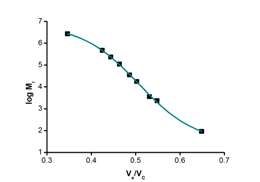
The inverse application of the size-exclusion chromatography (SEC) concept, inverse size-exclusion chromatography (ISEC) [1], utilizes a set of molecular probes with defined sizes to determine pore dimensions, and is also referred as chromatographic porosimetry [2].
ISEC provides an alternative to mercury porosimetry or nitrogen adsorption for the determination of the pore size dimensions and the surface area of chromatographic stationary phases. This technique was developed by Halász [3], and has subsequently been extended and refined [4,5,6].
ISEC methodology has been applied to the characterization of a variety of chromatographic stationary phases, including silica [4,5,7,8], silica modified with bonded-phases [9,10] or coated with formamide [11], alumina [8], series of carbohydrate-based size-exlusion gels [6] and synthetic polymer-based adsorbent [12]. The non‑destructive nature of ISEC is and advantage also in structural characterization of monolithic columns [13].
In comparative studies between porosimetry techniques and ISEC, the ISEC method was perceived to require fewer assumptions than mercury porosimetry (e.g., contact angle and surface tension) [5], and to be superior to nitrogen adsorption for following the changes in the surface area, pore volume and pore dimensions that resulted from the grafting of polymeric coatings onto silica [7].
Advantages of inverse size-exclusion chromatography
ISEC has a number of advantages over alternative methods. Column experiments with intact samples packed in a bed can conserve sample integrity and are easy to carry out, as proposed to the special sample preparation procedures in electron microscopy. No other additional equipment other than a chromatography system is necessary for ISEC, so it is relatively inexpensive and convenient.
Operating conditions such as high pressure, low temperature and drying conditions, which are involved in gas sorption or mercury intrusion, are not imposed in ISEC. Experimental conditions similar to those in normal operations result in less significant morphological changes, thus assuring structural information that is relevant to properties of functional interest.
The working pore dimension range of 1 – 400 nm attainable by ISEC [3], which includes resolution not achievable by mercury porosimetry or gas sorption [3,14,15], is of major interest in studies of microporous materials for liquid chromatography.
Limitations
There are number of precautions necessary for realizing effective ISEC procedures. Retention differences are considered to result purely form steric interaction, so solute standards with low polydispersity, i.e., that are well-defined in size and shape, should be used for pore size distribution determination. Dilute standard solutions are typically used to reduce solute-solute interactions, especially aggregation. Appropriate ISEC probes and solvent conditions should be chosen to minimize solute-adsorbent binding and to avoid aggregation.
If these prerequisites for standard ISEC are not satisfied, alternative treatments of non‑standard ISEC must be used to extract the pore size distribution. Potential anomalies include solute adsorption that cannot be eliminated by manipulating solvent conditions and the polydisperse standards when monodisperse solutes are not available. Some adsorbents also contain large pores that are accessible even to the largest polymer standards typically used.
Consequently, the macropore volume cannot be quantitatively differentiated by ISEC, and it is difficult to determine accurately the interstitial volume in a column containing such macroporous media. Micrometer-size latex particles can be used as large probes for quantifying the composition of macropores [16], in this case extra care is needed in choosing the size of the filters and frits in the chromatography system.
References
- L.G. Aggebrandt, O. Samuelson, J. Appl. Polym. Sci., 8 (1964) 2801.
- A.A. Gorbunov, L.Y. Solovyova, V.A. Pasechnik, J. Chromatogr., 448 (1988) 307.
- I. Halász, K. Martin, Angew. Chem. Inter. Ed. (Engl.)., 17 (1978) 901.
- J.H. Knox, H.P. Scott, J. Chromatogr., 316 (1984) 311.
- J.H. Knox, H.J. Ritchie, J. Chromatogr., 387 (1987) 65.
- L. Hagel, M. Ostberg, T. Anderson, J. Chromatogr., 743 (1996) 33.
- K. Jerabek, A. Revillon, E. Puccillli, Chromatografia, 36 (1993) 259.
- L.Z. Vilenchik, J.A. Asrar, R.C. Ayotte, L. Ternorutsky, C.J. Hardiman, J. Chromatogr., 648 (1993) 9.
- I. Mazsaroff, F.E. Regnier, J. Chromatogr., 442 (1988) 15.
- W.Werner, I. Halász, J. Chromatogr. Sci., 18 (1980) 277.
- R. Nikolov. W. Werner, I. Halász, J. Chromatogr. Sci., 18 (1980) 207.
- P. DePhilllips, A.M. Lenhoff, J. Chromatogr. A, 883 (2000) 39.
- H. Guan, G.Guiochon, J. Chromatogr. A., 731 (1996) 27.
- A.J. de Vries, M. Lepage, R. Beau, C.I. Guillemi, Anal. Chem., 39 (1967) 935.
- N.V. Saritha, G. Madras, Chem. Eng. Sci., 56 (2001) 6511.
- Y. Yao, A.M. Lenhoff, J. Chromatogr. A, 1126 (2006) 107.
2 replies on “Inverse size-exclusion chromatography”
[…] The column efficiency strongly depends on the size and polarity of the cross-linkers in the polymerization mixture. The efficiency of capillary monolithic columns for low-molecular compounds increases with the number of methylene units in non-polar (poly)methylene dimethacrylate cross-linkers, correlating with decreasing proportion of large through pores (> 50 nm) and increasing proportion of smaller mesopores (2 – 50 nm), as determined by inverse size-exclusion chromatography. […]
[…] addition to these models we have compared mercury intrusion porosimetry and inverse size-exclusion chromatography porosimetry techniques. While mercury intrusion covers large range of pore sizes (nm – μm) […]